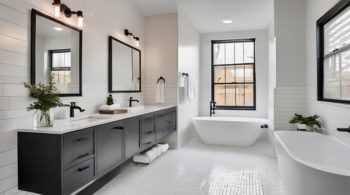When building your Home Assistant dashboard, balancing looks with functionality is key. You’ll want a clean layout that groups devices logically, uses cards for quick control, and employs badges for essential alerts. Navigation should be smooth, letting you switch between views without hassle. Paying attention to color and spacing improves readability and comfort during use. But what specific design choices make a dashboard both visually appealing and truly efficient?
Understanding the Basics of Home Assistant Dashboards
Home Assistant dashboards serve as the central control panels where you manage and monitor your smart home devices. They offer extensive dashboard functionality, allowing you to customize views to fit your needs.
You can modify the default “overview” dashboard or create new ones with unique titles, icons, and URLs. Views act like tabs to organize your devices, and layout options such as sections or sidebars improve user accessibility.
Badges and cards highlight important info and provide interactive controls. These features guarantee your dashboard is both functional and easy to navigate, making smart home management straightforward and efficient.
How to Create a Custom Dashboard From Scratch
When you want a dashboard tailored exactly to your needs, creating one from scratch is the best approach.
Start your custom dashboard creation by going to dashboard settings and choosing to create a new dashboard. Give it a title, pick an icon from the material design library or leave it blank for the default, and set a URL. You can control who sees it by adjusting visibility options like admin-only access.
Focus on dashboard layout optimization by adding views and using layout styles such as sections or masonry. For precision, edit YAML to fine-tune card attributes and arrangement.
Organizing Your Dashboard With Views and Sections
You’ll want to name each view clearly to make navigation simple and intuitive for everyone using your dashboard.
Group related cards into sections within those views to keep your layout organized and visually appealing.
With drag-and-drop features, you can quickly rearrange these sections and cards as your needs change, keeping your dashboard flexible and efficient.
Effective View Naming
Although organizing your dashboard might seem straightforward, choosing effective names for your views and sections plays a crucial role in making navigation intuitive and efficient.
Using clear view naming strategies helps you quickly identify each tab’s purpose, especially when tailoring layouts for different user role considerations. Keep names concise and descriptive to guide users effortlessly.
- Reflect the content or function of each view
- Use consistent naming conventions across sections
- Consider user roles when setting visibility and titles
- Avoid overly technical or vague terms
- Update names as your dashboard evolves
These tips guarantee your dashboard stays user-friendly and organized.
Section Grouping Benefits
Since organizing your dashboard efficiently can greatly impact how quickly you find what you need, section grouping offers a practical solution by letting you arrange related cards under clear headings.
This approach highlights the section customization benefits, allowing you to title each group and tailor cards to your preferences. By doing so, you create an intuitive navigation experience that simplifies locating specific controls or entities.
Additionally, sections can manage visibility based on triggers, keeping your interface clean and focused. Embracing section grouping helps you build a personalized, user-friendly dashboard that saves time and reduces clutter.
Drag-and-Drop Organization
Several features make organizing your Home Assistant dashboard straightforward and flexible, with drag-and-drop functionality playing a key role.
This feature improves user experience by letting you easily rearrange sections and cards, tailoring the dashboard to your needs. You can create multiple views, each with custom names and icons, to keep devices and functions neatly categorized.
Layout options like masonry and sidebar further enhance organization.
Here are the drag and drop benefits that help you stay efficient:
- Quickly reorder cards and sections
- Group related devices in sections
- Customize view names and icons
- Use multiple views for clarity
- Choose layouts for screen fit
Enhancing Dashboards With Badges for Quick Information
You can enhance your Home Assistant dashboard by using badges that show quick status updates like temperature or device states right at the top.
These badges come in different types—entity badges display specific data, while manual badges let you customize what appears.
You’ll also want to customize badge visibility so you only see the most relevant information when you need it, keeping your dashboard clear and efficient.
Badge Types Explained
Although dashboards can display a lot of detailed data, badges offer a streamlined way to highlight essential information at a glance.
Home Assistant features two main badge types: entity badges that show real-time device or sensor info, and manual badges for custom content you choose.
You’ll find badge customization options helpful for naming badges, selecting entities, and tweaking display elements.
While badge visibility settings control when badges appear, that’s a separate topic.
Here’s what badges do for you:
- Show device status instantly
- Display temperature or weather info
- Allow custom titles above badges
- Let you pick which entities show
- Keep your dashboard clean yet informative
Customizing Badge Visibility
When customizing badge visibility in Home Assistant, you gain control over which badges appear based on specific conditions, helping you keep your dashboard focused and relevant.
Use badge visibility settings to select entities and set visibility rules tied to their states, ensuring badges show only when needed. This approach reduces clutter and highlights critical info.
You can also name badges to clarify their purpose. Dynamic badge updates let your dashboard respond instantly to changes, keeping your display current without manual adjustments.
Quick Status Insights
How can badges transform your Home Assistant dashboard into a hub of quick, essential information? By using smart badge placement strategies, you highlight crucial data like temperature or device status right where you need it. This gives you instant updates without digging through menus.
Tracking badge performance metrics helps you see which badges provide the most value, so you can optimize your layout. Consider these tips:
- Place badges at the top of views for immediate visibility
- Use entity-specific badges for relevant quick info
- Customize badge names for clarity
- Set visibility conditions to reduce clutter
- Monitor badge usage to refine your dashboard
Using Cards to Build Interactive and Functional Interfaces
Since cards serve as the building blocks of Home Assistant dashboards, mastering their use is essential for creating interactive and functional interfaces.
You can use card customization options like naming, icons, and layout changes to tailor information display exactly how you want it. Interactive card designs, such as the Tile card, let you set different tap behaviors, making controls more intuitive.
Conditional visibility settings help you display cards only when relevant, keeping your dashboard clean and focused. By combining these features, you’ll build efficient, user-friendly dashboards that respond dynamically to your home’s status.
Advanced Customization With Custom Cards and Card Mod
Many users find that custom cards and Card Mod greatly elevate their Home Assistant dashboards by adding both style and functionality.
You can enhance custom card aesthetics using Mushroom cards and CSS tweaks via Card Mod to create a seamless look. Conditional visibility benefits let you show cards only when relevant, keeping your interface clean and interactive.
Consider these tips:
- Use stacking cards to combine multiple views efficiently
- Apply Card Mod to remove borders or adjust fonts
- Enable conditional visibility based on entity states
- Customize Mushroom cards for tailored design
- Experiment with CSS for unique visual effects
This approach boosts both form and function.
Implementing Navigation Links for Seamless User Experience
When you implement navigation links in your Home Assistant dashboard, you create a smoother path for users to move between different views or device pages.
Navigation customization lets you tailor these links, offering quick access to the most important features while reducing dashboard clutter. By organizing navigation thoughtfully, you improve flow and make it easier for users to find what they need.
Plus, you can enable user role based navigation, showing or hiding links depending on who’s logged in. This guarantees each user experiences a dashboard tailored to their specific needs, boosting usability and efficiency.
Tips for Designing Visually Appealing and Practical Dashboards
When designing your dashboard, start by choosing a cohesive color scheme that makes information easy to read and visually balanced.
Focus on creating a user-friendly layout that groups related elements logically, so maneuvering feels intuitive.
Don’t forget to integrate useful widgets that provide quick access to key data without cluttering the screen.
Choose Cohesive Color Schemes
Although choosing colors may seem simple, selecting a cohesive color scheme for your Home Assistant dashboard plays an essential role in both appearance and usability.
Achieving color harmony guarantees your interface feels balanced and inviting, while considering emotional impact influences how users interact with your dashboard.
Keep these tips in mind:
- Use 3-5 complementary colors to avoid clutter
- Apply consistent colors across badges and cards
- Choose colors that evoke the desired mood, like calming blues or energetic warm tones
- Test color contrast for readability and accessibility
- Maintain uniformity to help users quickly identify key information
This approach creates a visually appealing and practical dashboard.
Prioritize User-Friendly Layout
Since a well-organized layout directly impacts how easily you navigate your Home Assistant dashboard, prioritizing user-friendly design is essential.
Start by grouping related cards under clear headings to improve dashboard accessibility and make finding information intuitive. Choose a layout style like masonry or panel that fits your content and keeps the interface clean.
Use badges at the top of views for quick, glanceable data, and add navigation links to direct you swiftly to device pages or other views.
Customizing card options lets you tailor both appearance and function, enhancing usability and keeping the dashboard engaging.
Integrate Useful Widgets
Organizing your dashboard with a user-friendly layout sets a solid foundation, but integrating useful widgets brings functionality and visual appeal to the next level.
Employ effective widget placement strategies to display key info, like weather badges at the top for quick checks. Enhance interaction by using tap behavior on cards to trigger actions or reveal details.
Experiment with stacking cards for a compact, cohesive look. Don’t forget to group related cards under clear headings and explore custom cards like Mushroom for unique styles.
These interactive widget features make your dashboard both practical and engaging.
- Use badges for quick status updates
- Group related cards with customizable headings
- Incorporate custom Mushroom collection cards
- Apply tap behavior to reveal more info
- Stack cards for precise layout control
Common Pitfalls to Avoid When Building Home Assistant Dashboards
When building your Home Assistant dashboard, you need to avoid adding too many cards and entities, as this can quickly overwhelm you and anyone else using it.
Dashboard clutter makes it hard to locate key info, reducing usability. Be selective—include only relevant badges and cards that serve clear purposes.
Use visibility conditions wisely to display information based on entity states, keeping your dashboard clean and focused.
Watch out for area dashboards pulling in unwanted entities, which creates confusion.
Regularly review and adjust your layout to accommodate changes, ensuring your dashboard stays organized and effective over time.
Engaging With the Community and Sharing Your Dashboard Ideas
Although building your Home Assistant dashboard is a personal project, engaging with the community can greatly enhance your experience. You’ll find plenty of community inspiration and opportunities for dashboard collaborations that boost your creativity and skills.
Here’s how you can benefit:
- Share your dashboard setups on Reddit or Discord to get feedback.
- Participate in forums to ask questions and exchange ideas.
- Join community challenges to push your dashboard design limits.
- Collaborate with others to discover unique card designs.
- Use shared examples to refine your layout strategies.
Connecting with others makes your dashboard better and more enjoyable.
Frequently Asked Questions
Can I Integrate Voice Control With My Home Assistant Dashboard?
Yes, you can integrate voice control with your Home Assistant dashboard by using voice automation tools and smart assistants like Google Assistant or Alexa. This lets you control devices hands-free and enhances your smart home experience effortlessly.
What Hardware Is Best for Running Home Assistant Dashboards Smoothly?
You’ll get smooth Home Assistant dashboards using a Raspberry Pi 4 or Intel NUC options. Setting up a dedicated home server with performance tuning guarantees responsiveness and reliability, letting you control everything seamlessly without lag or glitches.
How Do I Back up and Restore My Dashboard Configurations?
You can back up your dashboard configurations by exporting the dashboard export file from Home Assistant. Use configuration management tools or snapshots to save and restore your setup easily whenever needed, ensuring your customizations stay safe.
Are There Mobile App-Specific Dashboard Optimizations?
Yes, you can optimize your dashboard for mobile by customizing the app interface to fit smaller screens. Mobile optimization guarantees buttons, widgets, and layouts adjust smoothly, giving you a seamless and user-friendly experience on your device.
Can Dashboards Display Real-Time Energy Consumption Data?
Yes, you can display real-time monitoring of energy consumption on dashboards. They provide energy analytics that update instantly, letting you track usage patterns and optimize efficiency directly from your Home Assistant interface.
Christina Pulluck helped bring Nebula Electronics from a a science and tech decision forum to a full-fledged news site by creating a new design and branding. She continues to assist in keeping the site responsive and well organized for the readers. As a contributor to Nebula Electronics, Christina mainly covers mobile news and gadgets.







